Key takeaways:
- Environmental storytelling conveys themes and emotions through visual and auditory elements without the need for words, fostering a deep connection between players and narratives.
- Key elements include personal resonant details, spatial design to suggest stories, and sound design that enhances atmosphere and emotional impact.
- Effective techniques involve character anchoring, pacing of information reveal, and creating suspense to engage the audience fully.
- Tools like Unity, Twine, and sound design software are crucial for building immersive storytelling environments that evoke emotions and enhance narrative experiences.
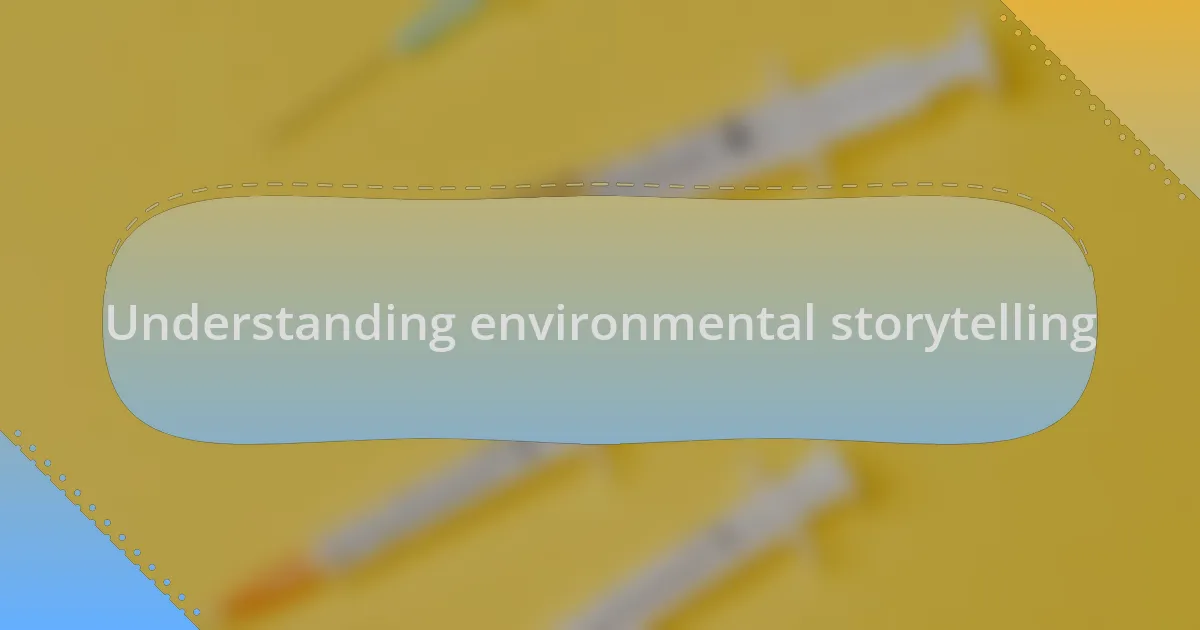
Understanding environmental storytelling
Environmental storytelling is a powerful narrative where the setting itself plays a critical role in conveying themes and emotions. I remember the first time I explored a game world that told its story through ruins, weathered objects, and even the sounds of nature. I found myself thinking, what if every detail around me held a deeper meaning, waiting to be discovered?
One facet of environmental storytelling that fascinates me is how it can evoke emotions without a single word being spoken. For example, the way a desolate landscape filled with broken structures can create a sense of loneliness can be striking. I can still feel the weight of that solitude from a game that immersed me in a post-apocalyptic world, making me question how our own environment might reflect our choices or even our traumas.
Creating a story through the environment requires not just keen observation but also a profound understanding of design. It makes me think about how important it is to consider the emotional impact of every element placed in a scene. Have you ever stopped to think about the stories behind the objects we overlook every day? Whether it’s a crumbling wall or a vibrant flower, they all contribute to the larger narrative, waiting for someone to piece them together.
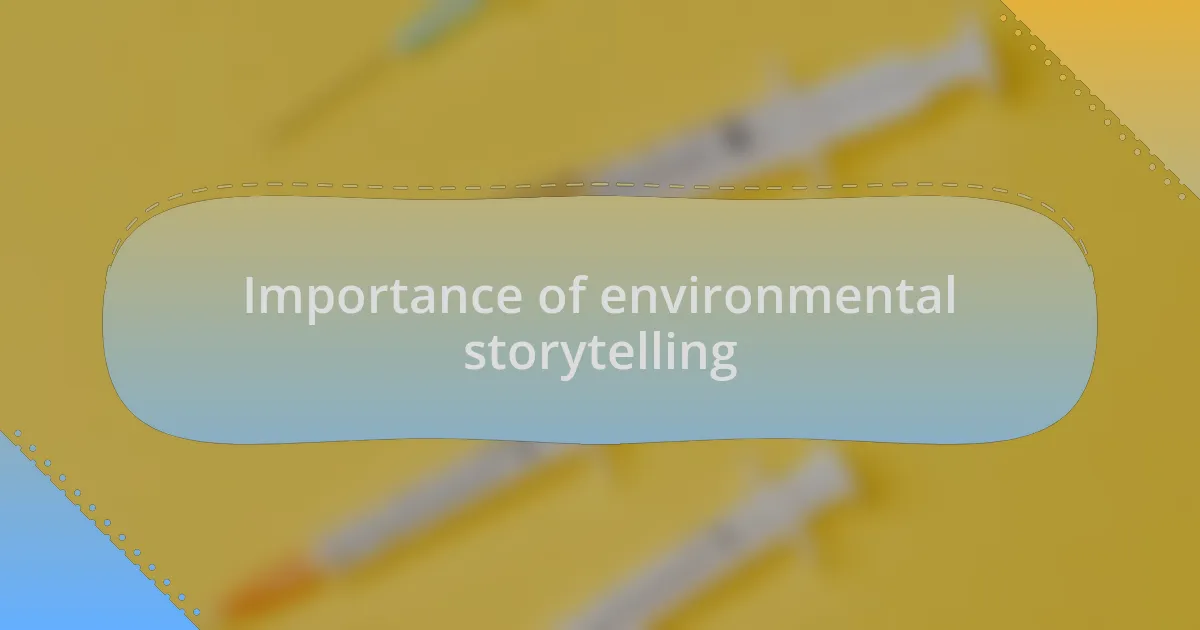
Importance of environmental storytelling
Environmental storytelling serves as a bridge between the player and the narrative, allowing for a deeper connection with the world being explored. I think back to a game where the smallest details—like a family photograph left on a table—tell you everything about the lives once lived there. It makes you wonder, doesn’t it? How does the presence of a simple object transform your understanding of a character’s past?
The ability of the environment to convey cultural and emotional context is striking. I recall wandering through a richly designed cityscape where every alley and mural revealed a hidden history, urging me to explore more. This immersive approach encourages players to engage actively, sparking curiosity and prompting reflections on broader themes. Isn’t it fascinating how these elements can deepen our empathy toward fictional lives?
Moreover, environmental storytelling allows creators to convey complex themes without overwhelming the audience with exposition. In a recent project, I carefully chose elements—a child’s toy in ruins—to elicit a conversation about innocence lost amidst chaos. The slightest detail can transform an ordinary space into something profound, compelling players to reflect on their own experiences. How often do we overlook the stories waiting to be uncovered in our surroundings?
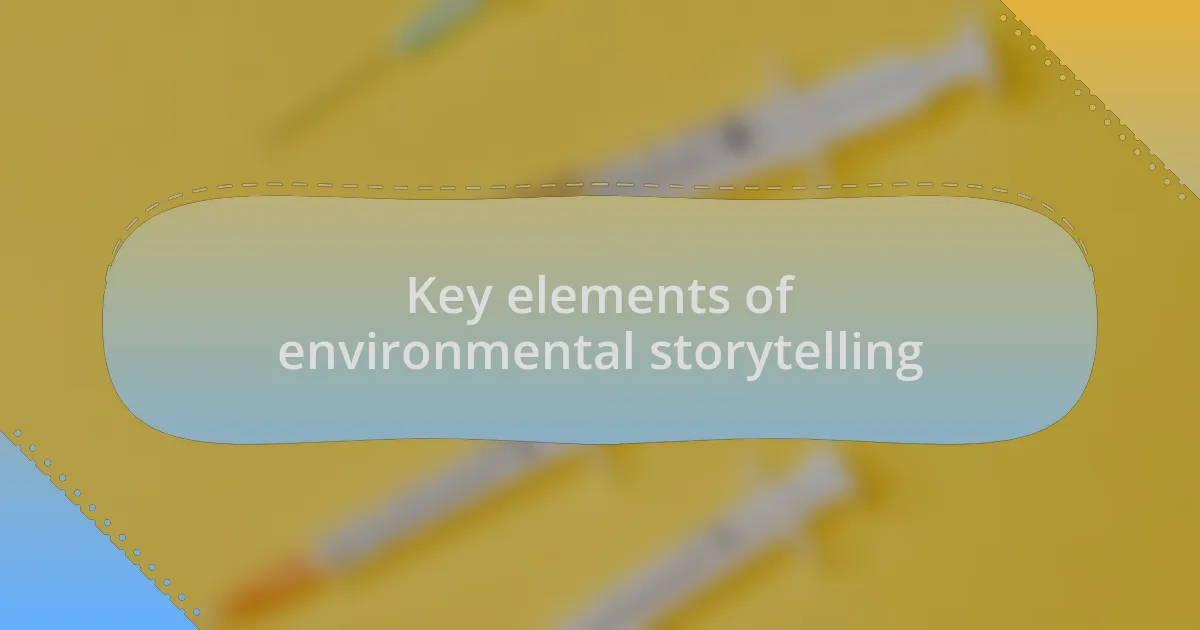
Key elements of environmental storytelling
Key elements of environmental storytelling often include details that resonate with the audience on a personal level. For instance, I once stumbled upon a battered book in a game that enchanted me with its worn pages and tattered cover. It instantly sparked my curiosity about the reader who once cherished it, leading me to ponder how their story intertwined with the fictional world.
Another crucial element is the use of space and layout to convey narrative without words. I remember navigating a desolate village in a game where the placement of abandoned structures and scattered belongings told a story of sudden departure. This clever design made me reflect on the concept of loss and what once thrived there. How can a silent space evoke such powerful emotions?
Finally, sound design plays a significant role in shaping the atmosphere of a story-rich environment. The echoes of distant footsteps or the faint rustling of leaves can instill a sense of presence and urgency. In one memorable experience, a subtle score and ambient sounds amplified my tension as I ventured into a foreboding jungle, making me acutely aware of my surroundings. Isn’t it amazing how sound can enhance the storytelling experience?
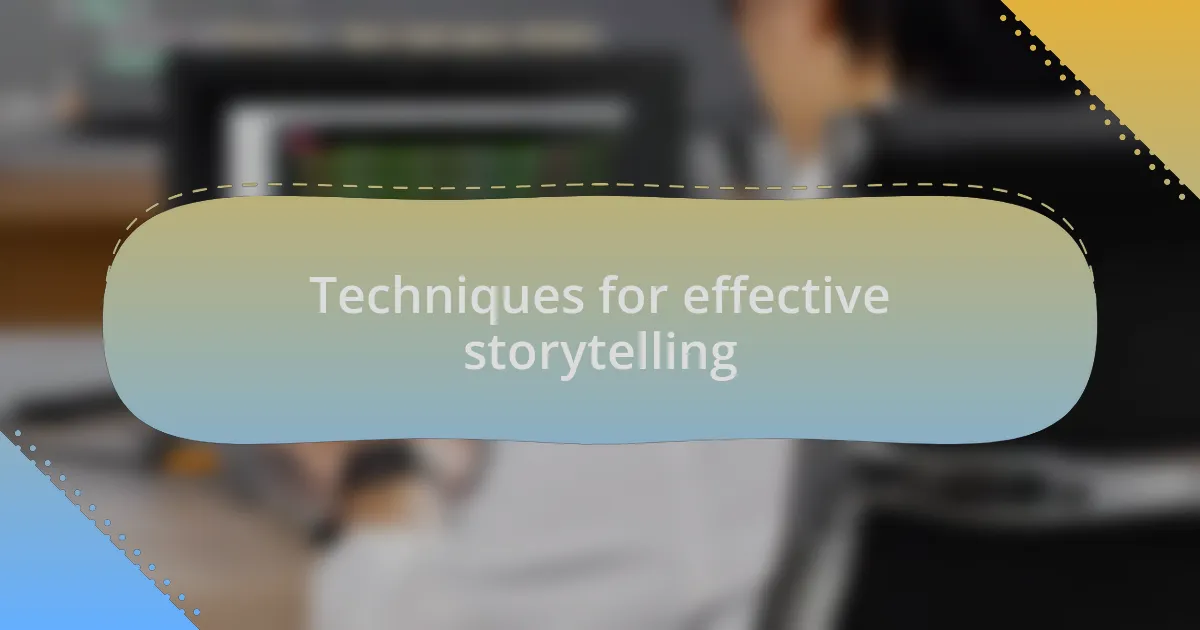
Techniques for effective storytelling
One technique I’ve found effective in storytelling is the power of characters to anchor the narrative. I recall a moment in a narrative-driven game where I connected deeply with a lone survivor navigating a post-apocalyptic world. Their personal struggles and decisions became my own, allowing me to invest emotionally in their journey. How often do we find ourselves rooting for characters, feeling their joy and pain as if they were our own?
Another important method is the careful pacing of information. In one immersive experience, I encountered hidden lore gradually revealed through environmental clues. I delighted in piecing together the backstory bit by bit, which fueled my intrigue and made the eventual revelations more impactful. Isn’t it fascinating how uncovering details at just the right moment can enhance the thrill of discovery?
Lastly, creating suspense can significantly heighten engagement. There was a time when I faced a critical choice in a story, with stakes so high that my palms felt sweaty. The looming uncertainty of the consequences made every decision feel monumental. This tension kept me on the edge of my seat, and I wondered how often we miss opportunities to cultivate such suspense in our own storytelling endeavors.
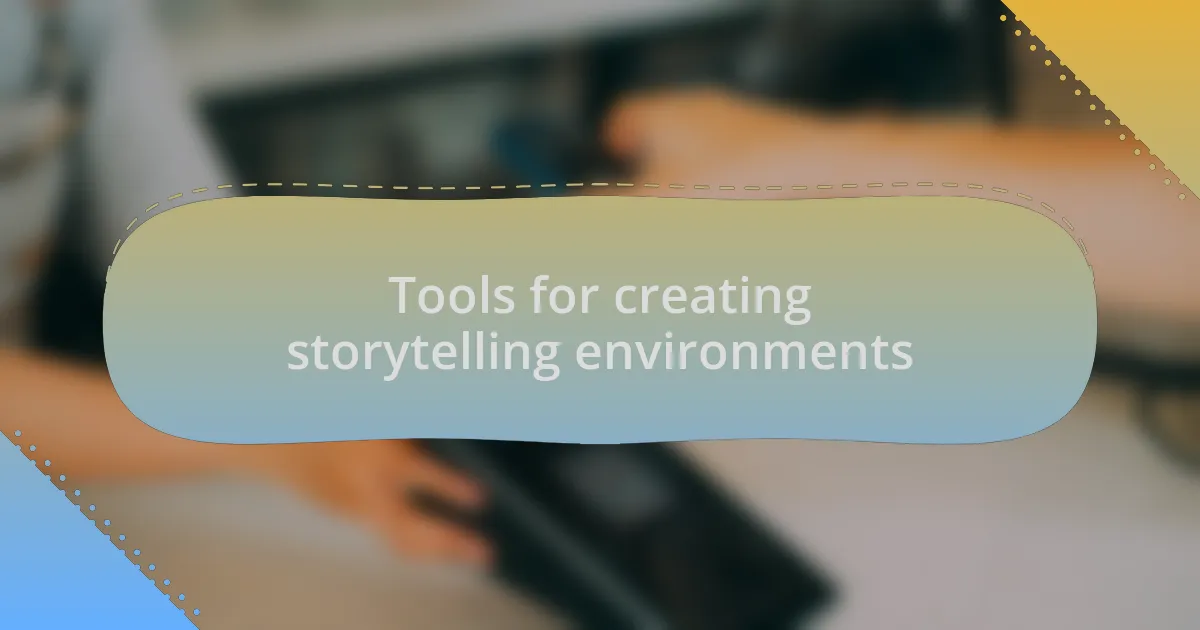
Tools for creating storytelling environments
When it comes to tools for creating storytelling environments, software like Unity and Unreal Engine stand out. I remember my first time using Unity to develop a game level — the sheer possibilities felt limitless. It was thrilling to see how manipulating space and light could evoke different moods and atmospheres. Have you ever experienced that moment when you realize just how much impact a simple change in ambiance can have on storytelling?
Another powerful tool is Twine. This versatile platform allows for interactive narratives where choices guide the story’s path. I got lost in a Twine project once, crafting a branching story that felt alive with decision-making. It was incredible to witness how each choice altered the course of the narrative, leaving me to question: how often do we consider the impact of our decisions in storytelling?
Lastly, consider the importance of sound design with tools like FMOD or Wwise. I can still recall a scene where subtle background noise coupled with an emotional score completely transformed my understanding of a character’s plight. Sound isn’t just an accessory; it’s a narrative force that can convey emotions more powerfully than words alone. Isn’t it interesting how sound can pull you deeper into a world, making every experience more visceral?
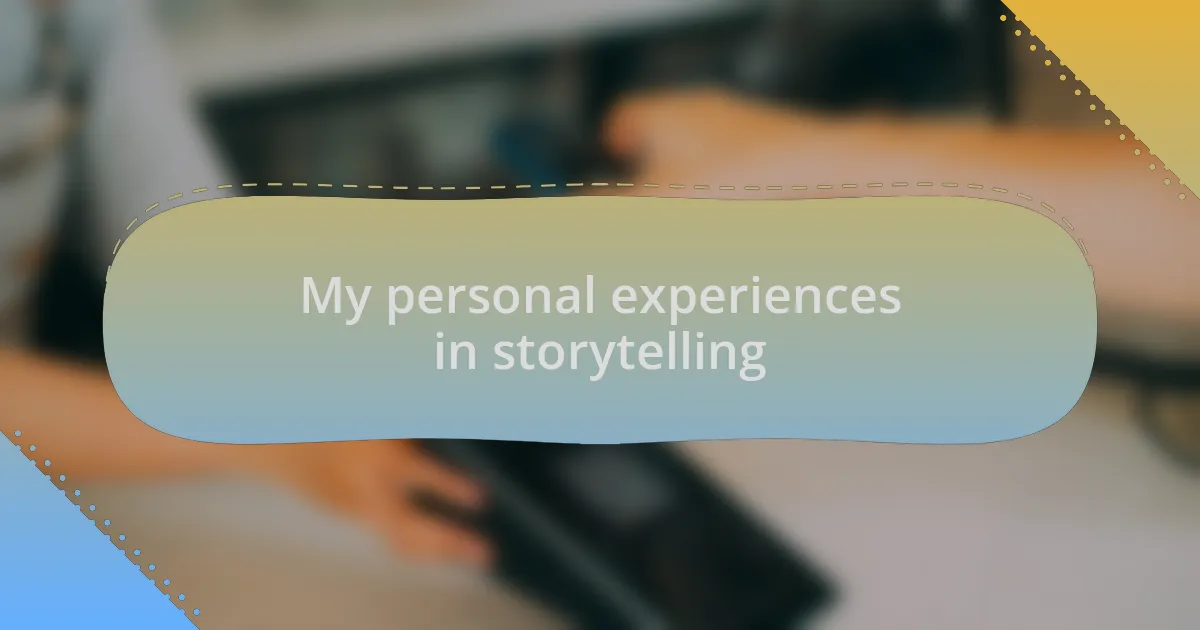
My personal experiences in storytelling
Storytelling has been a significant part of my creative journey. I once participated in a community storytelling event where I shared a personal anecdote about my connection to nature. It was remarkable to see how my simple narrative about a childhood camping trip resonated with others, sparking conversations about their own experiences. Have you ever noticed how one story can create a bridge between people, making seemingly different lives feel similar?
In another instance, I experimented with visual storytelling while working on a digital art project. I chose to depict my favorite place in the woods, infusing it with vibrant colors to reflect my emotions. Through this project, I realized how imagery can evoke nostalgia and longing, much more than words could express. It made me think: how often do we rely on visuals to tell deeper, more complex stories that words struggle to capture?
Lastly, I recall an instance during a workshop where we were asked to collaborate on a story as a group. Each person contributed a line, and what started as a simple sentence evolved into a rich tapestry of ideas and emotions. I was amazed at how collective storytelling can unveil perspectives I had never considered. What if we viewed our stories as collaborative efforts, each person adding their unique voice to create something truly extraordinary?